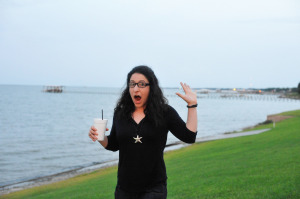by Sam Tackeff | Sep 27, 2012 | Baking, Blogging, Books, Holidays
Yesterday was Yom Kippur, the most sacred day of the Jewish year, the day of atonement. It follows at the tail end of Rosh Hashana, the week long celebration of the Jewish new year, and typically is the day that you reflect upon all of your sins and bad deeds. While I’m not particularly religious anymore (despite the fact that my mother has served on the board of our synagogue and is currently on the education committee), I do consider myself quite spiritual, take great comfort in many of the tenets of the faith, and particularly relish the holidays.
Most Jews fast on Yom Kippur, abstaining from food and drink, and aside from a cup of coffee, I did as well. One of the things that I wanted to do on this day was spend some time thinking about what it means to live without. For the past several weeks I’ve been choosing to abstain from foods, certain bad habits, and negative thought patterns. It has been a challenge. One of the great things that has come out of it is a desire to share with you all some of the changes I’ve been making, and I’ve been really moved by all the support that I’ve received. I’m not taking any of this for granted, I feel particularly lucky.
On the topic of living without, I spent a good part of the day reading Shauna James Ahern’s ‘Gluten-Free Girl: How I Found the Food That Loves Me Back & How You Can Too‘. Shauna writes a beautiful blog, about food, family, and her life – choosing to make living without gluten a practice in living fully and well.
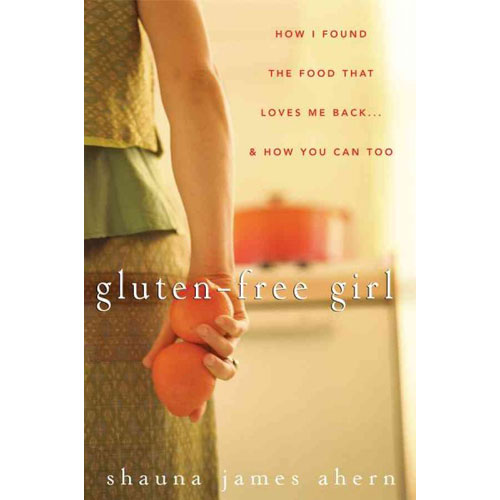
In her pages she is candid about her experiences with Celiac disease, and living gluten free, but it’s about so much more than a life without – it’s about discovery, learning to eat well, learning to love food, learning to live fully. Learning to say yes.
The book skips through her life, from her childhood in California with quirky parents eating TV dinners and Clark Bars, traveling the world, teaching high school English on Vashon Island, a stint in New York in her early 30’s, living in England with an absurdly wealthy family for 6 months, to finding herself back in Seattle where she ends up falling in love with the man she would later marry. (And have an adorable daughter with. But that comes after the book!)
The pages are filled with food memories, friendship, first tastes, and recipes. I spent the afternoon smiling, tearing up, and (very) hungry.
This book came out in 2007, and I’m ashamed to say that I hadn’t read it until now. I don’t know Shauna personally, but she knows several of the friends that I made over the years at Omnivore Books, and my heart lifted to see so many of them mentioned in her wonderful book.
* * *
After regretfully reaching the last page, I put the book down and headed into the fresh air to walk around the neighborhood before heading to our family feast to break the fast. I wandered into this guy.
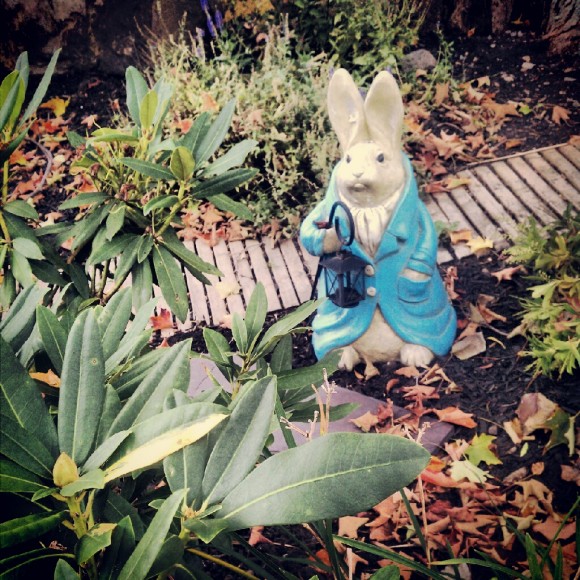
By the time I got back from my walk, Devon had returned home and we drove over to my aunt and uncle’s house together. The sun had sufficiently set, and so I made a beeline to the appetizer table, where I immediately proceeded to gorge myself on carrots, cucumbers, and fresh pistachios that my mom had brought back from her trip to Istanbul. (I abstained from the lovely cheese selection, hummus, and chopped liver, but I thought it was a nice spread.)
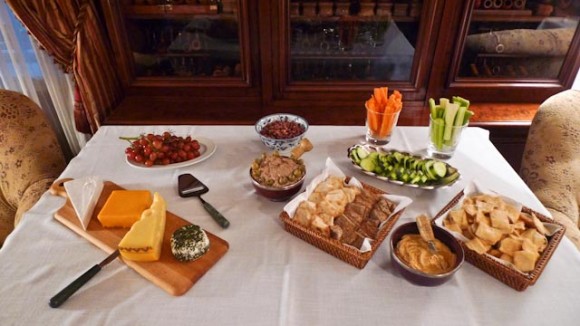
Because my aunt works magic, the table had been set: bagels, lox, multiple types of kugel (noodle pudding), herring with blueberries, cranberry sauce, fruit compote, mini challah, and bread. For our family, Yom Kippur ends up being a cross between traditional Jewish foods and Thanksgiving.
That’s Cooper, 6 months old, eying the gefilte fish.
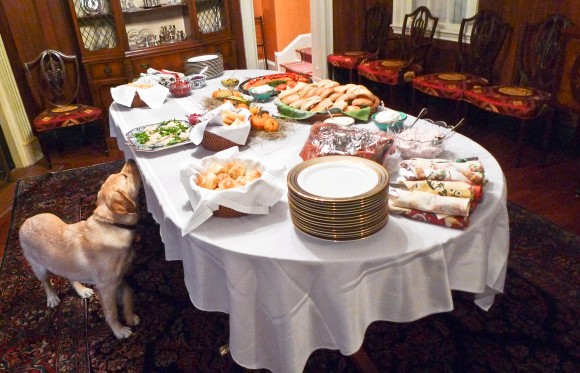
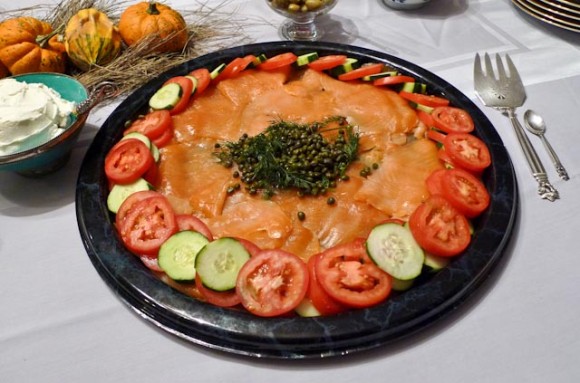
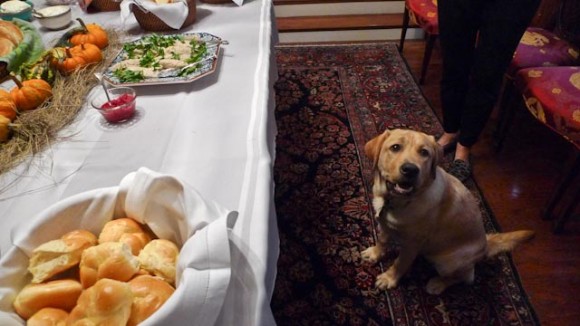
If you insist Coop, you can definitely have my gefilte fish! Mmm.. carp! (I should note here that in addition to some excellent training – he can now heel, lie down, roll over, and shake – he is also learning good manners and isn’t being served people food. I’m totally impressed by my cousin-pup!)
The highlight of the meal was actually this turkey.
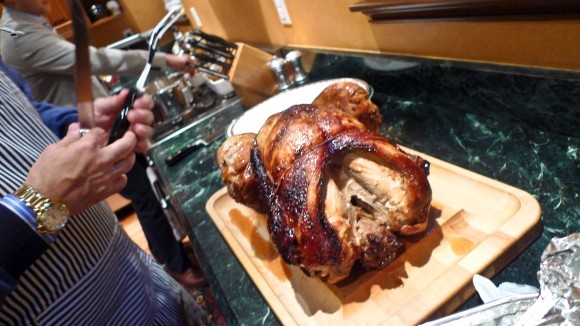
While I knew that I would have to hold back from so many of my favorites (Cheryl Ann’s mini challah rolls!), I didn’t find myself wanting. Here’s my dinner plate – turkey, pistachios, carrots, tomatoes, cucumber, and a whole bunch of pineapple. I sat myself down strategically next to the carved turkey, so when I finished this plate, I ended up having another half pound of bird. It may have been slightly excessive.
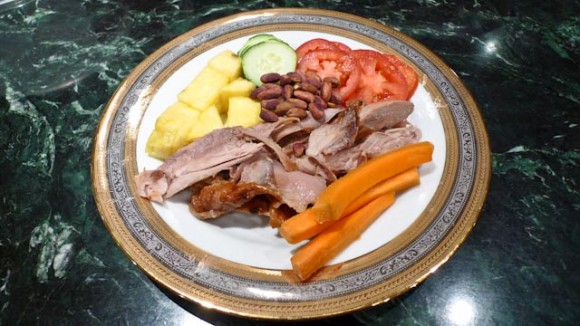
For dessert, I had more fruit, and a cup of coffee. Because of this challenge, yet a second holiday in a row where I’ve abstained from dessert. It was… a challenge. The spread included my mom’s apple cake, my favorite pumpkin chocolate chip cake, my aunt’s spectacular banana bread, and Eleanor Bloom’s famous brownies – dense, fudgy, chewy, and perfect from the freezer in the middle of the night.
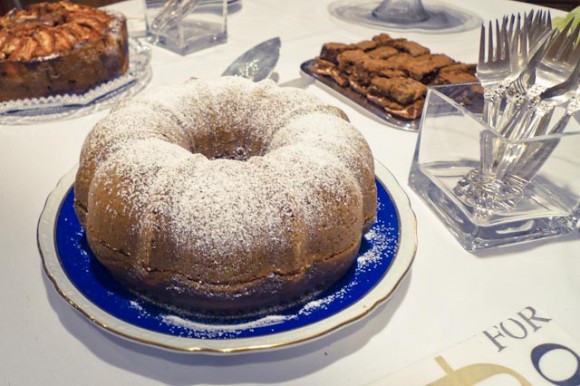
Next time!
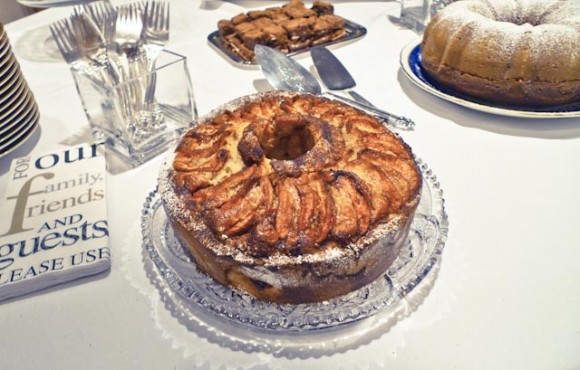
Happy Holidays to my kinfolk!
by Sam Tackeff | Sep 26, 2012 | Blogging, Books, Challenge, Lists
A few thoughts on list-making. When I read, I make lists. When I walk in the woods, I make lists. I think best in lists. God forbid I find myself without a pen, because I’ll get downright cranky. Perhaps that’s why I dislike long showers. I fear that I’ll forget those small flashes of thought that tend to flicker through my head as my eyes are shut and the water rushes down my face.
And then there is the joy of choosing what to write your list on. I have lists on my computer, on a whiteboard by the side of my bed, but physical tactile lists are undeniably the best. My uncle, who I should note has particularly fine taste, has his own monogrammed mini note pads that fit in his wallet and he carries around at all times. I have notebooks big and small. My favorite, usually, is my smallest moleskine, which has a pocket to keep the lists that didn’t make it in the book and were scribbled on the back of an old envelope, receipt, or library slip.
There is little I like better than writing my lists, except perhaps, reading other people’s lists. I have much to thank my friend Kassie for over the years, but I owe her the biggest debt of gratitude for introducing me to Maria Popova’s Brain Pickings, filled with the lists of creative people throughout history. If you’d like to procrastinate, click on that link.
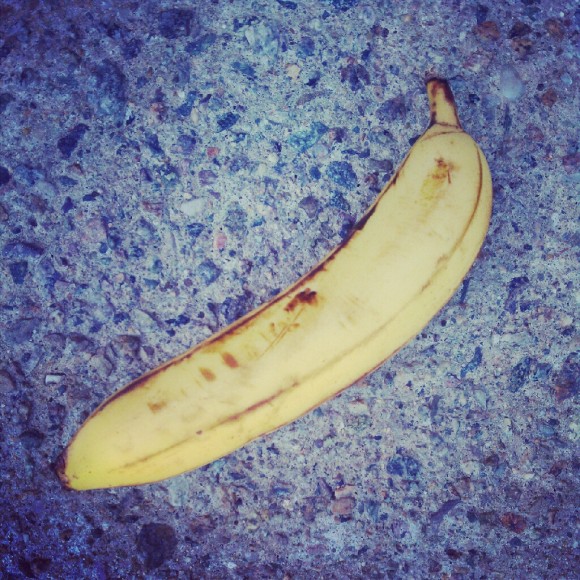
This was the banana that I ate directly following my morning workout. I headed to CrossFit with trepidation. We’d be working on three things that I’m not good at: pull-ups, hang squat snatches, and toes to bar. One of my biggest challenges with CrossFit has been keeping a positive attitude when I’m not good at something. When you’ve lived your life competing with over-achievers, accepting that you are not good at something takes some effort.
But I’ve surprised myself at how quickly I’ve found joy from my progress at the gym, tackling new challenges that seem insurmountable. Each day I learn something new, I become both physically and mentally stronger, and this keeps me coming back week after week. These days I’ve been coming and going with a smile on my face.
Tuesday WOD 9/25/12
Strength
A. Back Squat – 6 Sets of 4 @ 80% of your 1 rep max, rest 2:30 between sets (20 min. cap total)
B. Strict Weighted Pull-up – 8 minutes to a heavy set of 3 reps (if you can’t do them, practice pull-ups and kipping for your TTB)
WOD (workout of the day): “Black Bart”
AMRAP 8 Ladder of 2,4,6,8, etc.
Hang Squat Snatch 95/65
Toe To Bar
This was not an easy day for me. My two rep max is 95, and although I hadn’t found my one rep max, Coach E determined that I’d work with 80 pounds for my back squat. I’ve been working on keeping my heels down, sticking my butt out, and squatting down low. I felt good at the end of my sets, gaining confidence that I’m building up muscle. I definitely can go heavier.
And then came the pullups. Up until now I’ve been doing jump-ups standing on a 24 inch box to jump up over the bar. Today, we pulled out the green band. Three pullups no problem. (I surprised myself here). And then the blue band (less resistance) – three more down (huh…) . The red? Okay, so I got one. But now I know that I can do this.
After our strength we had our WOD. My technique on my lifts could use some work, so I ended up dropping the weight down to 35#. Because I have to learn how to hang properly on the rig, I ended up with knee raises instead of toes to bar. Toes to bar is infinitely more difficult than when I was six and could do it easily. I think I need more time on the playground. Result? In eight minutes I got past the 8’s and 3 lifts in.
(Black Bart, for the record, is one of my favorite outlaws. He was a poet, and would leave verses at crime scenes!)
“I’ve labored long and hard for bread,
For honor, and for riches,
But on my corns too long you’ve tread,
You fine-haired sons of bitches.”
When I came home, I made myself this superbly good bowl of leftover beef stew. Having eaten all the meat off our marrow bones the night before, I cooked up some crumbled fresh sausage from the butcher shop and then heated up the leftover carrots and braise. I topped it all with some fresh parsley and lemon zest, and it was positively the best thing I’ve eaten in weeks. Recipe coming in the next day or so as soon as Yom Kippur is over and I can post my notes without this rumbling hunger. {Edited: recipe here!}
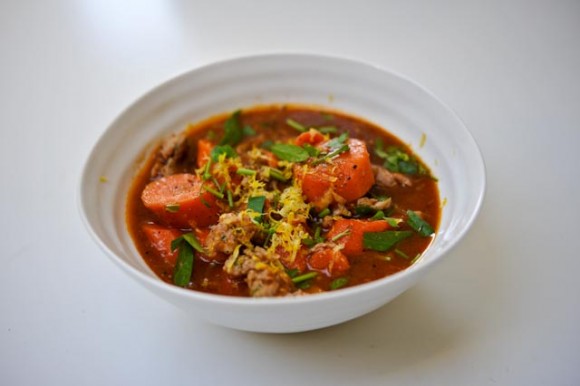
In the afternoon, I was craving something sweet, but decided that I’d make myself a treat for the evening – Chai Chia Pudding. I pulled out my favorite Masala Chai from Samovar, heated up a cup of coconut milk on the stove, and steeped a tablespoon of tea in the milk as it warmed.
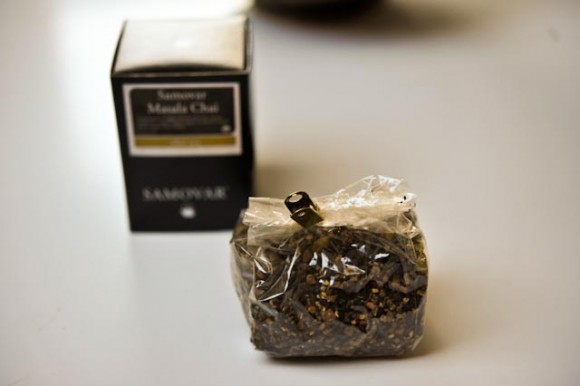
After about 5 minutes, I took the creamy tea-milk off the stove, and stirred in about a quarter cup of chia seeds. The seeds expand in the milk and make a gelatinous pudding. Typically I’d add a spoonful of honey to sweeten it, but I’ve been strict about no added sweeteners this month, and the warm spices are enough to satisfy me lately. I put it in the fridge to cool down for later.
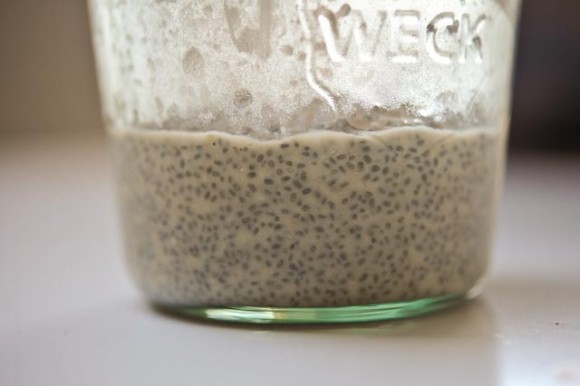
In the early evening I took my walk before Devon came home from work, just as the sun was setting. Just as I was coming home, I stumbled upon the IKEA drawer set I used to own (and loved) standing in someone’s front yard. I rushed home to get my car, drove over, and spent 15 minutes attempting to lift the thing by myself (not a problem now!), until I finally had to give up because there was no way it was going to fit in my tiny Volvo.
I headed to the store, silently praying it’d be there when Devon got back with the Tucson. It was not. You can’t win them all.
I did however win with dinner. I picked up a single packet of pre-cooked organic “love beets” at the store. Because I’m the only one around here who eats beets, this is the perfect convenience. I chopped my beets up and dressed them with cumin, coriander, salt and vinegar. I then set about cooking some grass fed beef with peppers and a tomato. Finally, I chopped up an avocado, heated up some spinach, and made myself this delightfully colorful plate:
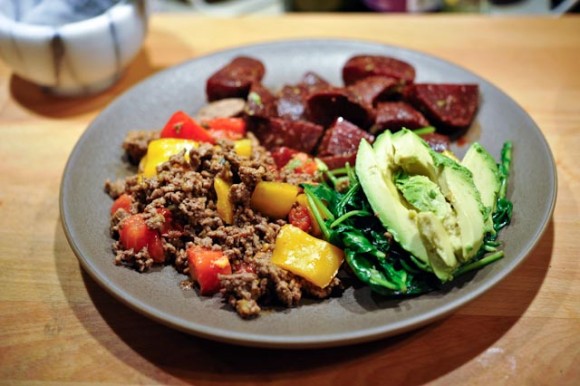
Devon got his with refried beans, and we sat together and ate happily. For dessert, I ate my chia pudding, and we watched Bourdain’s Sydney episode before falling asleep way too early to admit.
by Sam Tackeff | Sep 10, 2012 | Books, Seafood
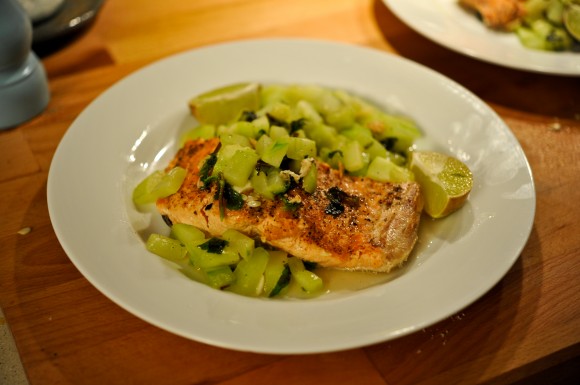
For the past few months I’ve been getting shipments of wild Alaskan salmon from Copper River as part of the Fresh Catch Crew. Folks who follow me on Twitter likely saw me tweet gleefully about it, live-documenting my gravlax making. I’ve posted on Facebook, and there have been many pictures on Instagram, but I’m finally sharing here on this somewhat neglected blog of mine. Why is it that social media seems to be taking up all of my time? I digress.
Let me begin by mentioning that fresh wild salmon from Alaska is seasonal, and is nothing like the sad, pathetic, light pink, often bland farmed stuff. Its deep orange flesh is rich, silky, nutrient dense, oily, and supremely flavorful. Most of the time I simply season my fish with salt and pepper, maybe a little cumin, and put it on the grill.
It’s nearing the end of salmon season, and I’m hoping that you’ll be inspired to pick some up before the summer ends, and make this recipe. It’s a dead simple one, from Melissa Clark‘s ‘Cook This Now‘.
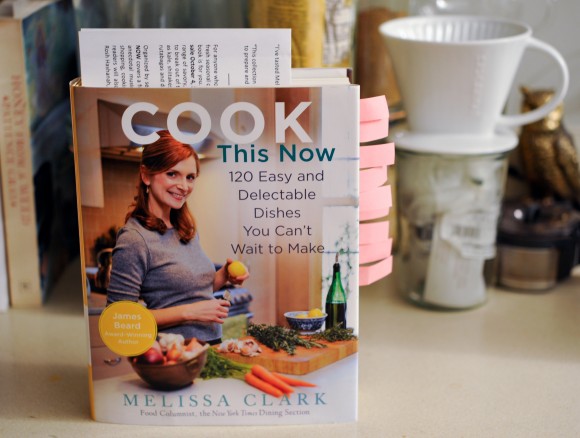
Melissa’s cookbook is one that I’ve turned to again and again in the past year – as you can see, it’s been tabbed up with stickies, and I’ve been consistently pleased with her recipes. There is something about Melissa that inspires confidence and creativity in the kitchen, and I’ve long admired her column in the New York Times. A few years ago we had the privilege of hosting her at Omnivore Books, and she was truly as lovely in person as I had imagined.
So about this fish.
Yesterday, a package was waiting, with the first of the Coho salmon. Copper River is home to King, Sockeye and Coho, and while most people seem to favor the King salmon, I have to say that I really enjoyed the wild Coho. Its generally a bit milder of a fish, and is quite versatile.
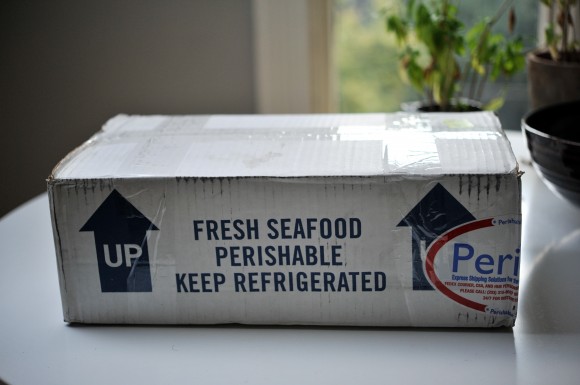
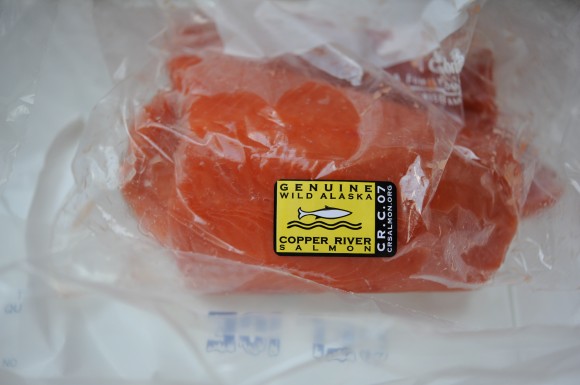
As soon as I took the fish out of the box, I set to work gathering my ingredients for dinner. This recipe has just a few ingredients – salmon, cucumbers, butter, garlic, fresh herbs and citrus. It’s something you could put together on a weeknight even if you are exhausted, and it feels fancier than it is.
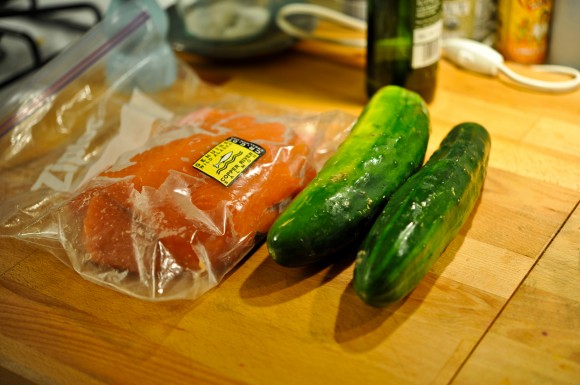
The first step, which of course, I managed not to get a picture of, is to heat the butter on medium high heat, and cook until foam subsides and turns to a deep golden hue, about 3 minutes. You’ll want to watch the pan for this – don’t be tempted to wander off, lest your butter burns and you have to throw it out and start over again.
If you wish, say, because you are on a month long Whole30, you can substitute ghee – which has some of the nuttiness, but won’t quite be the same. (I’ve made this recipe with both, with similar success.)
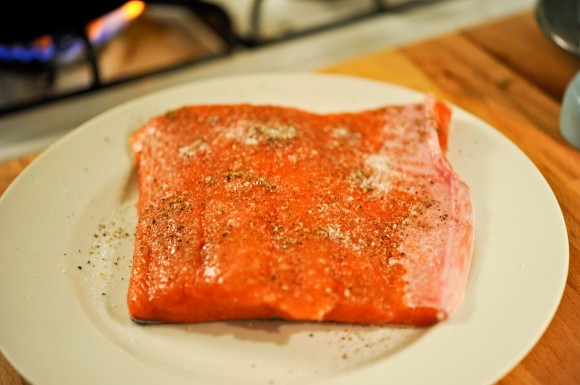
The next step, is to season your salmon with salt and pepper. The recipe calls for two 6-8 ounce filets, but I had a gorgeous one pound filet that I left whole. Add your fish to the pan, skin-side up, and cook for three minutes, resisting the urge to touch it, prod it, or poke it. This is a good time to peel and chop two cucumbers if you haven’t already.
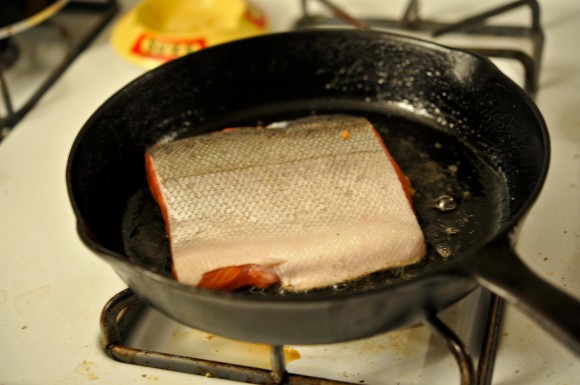
After three minutes, add your cucumbers, season them with salt and pepper, and gently stir to coat with the butter. After three more minutes, gently flip your fish, making sure that the skin gets good contact with the pan, and isn’t sitting on cucumbers.
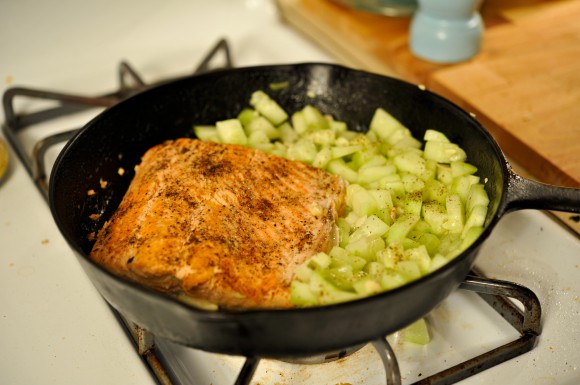
Add the minced garlic to the cucumbers, and cook for 2-4 more minutes, until the fish is done. I like my fish on the rare side, so I took mine out of the pan after two, but left Devon’s half in for an extra few minutes.
To finish the cucumbers, add fresh herbs – I added chopped mint, but dill and cilantro would be good as well – stir, and season to taste.
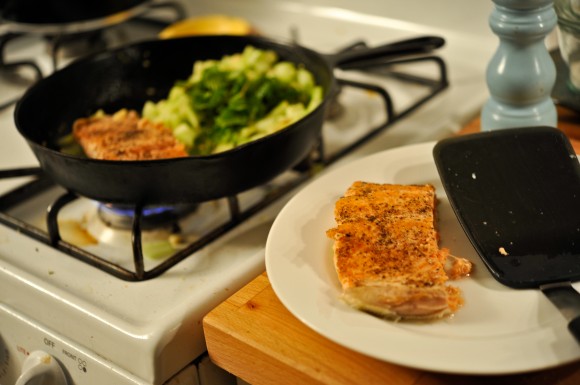
Spoon the cucumber and butter over the salmon, and serve with several wedges of citrus. I used lime, but you could also use lemon. The lime cuts the richness, and adds much needed pep to the dish. Don’t forget it!
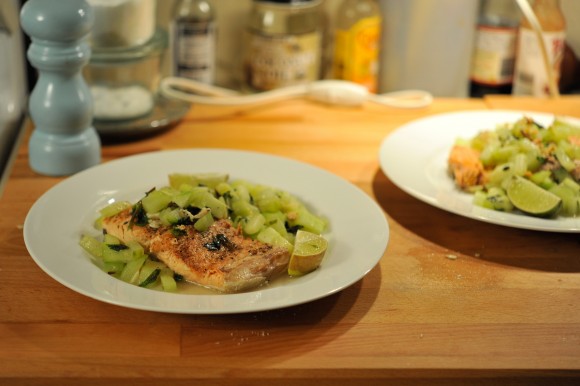
Melissa Clark’s Wild Salmon with Brown Butter Cucumbers
Find the original recipe here in the NYTimes
serves 2
2 tablespoons unsalted butter (or ghee)
2 thick, wild salmon fillets (6 to 8 ounces each)
Kosher salt or freshly ground black pepper
2 Kirby cucumbers, peeled and diced into 1/4-inch cubes
2 garlic cloves, minced
2 tablespoons chopped fresh herbs (dill, cilantro, or mint all go well here)
1 to 2 teaspoons fresh lemon or lime juice, more to taste.
1. In a large skillet, melt the butter over medium high heat, and cook until foam subsides and turns deep golden hue, about 3 minutes. If using ghee, note that there are no milk solids to foam and brown, but you can still let it cook for a few minutes.
2. Season your salmon filets with salt and pepper. Add the salmon skin side down, and let the filets cook for 3 minutes. Resist the urge to touch or fiddle with it. As you wait, peel and chop your cucumbers. Add the cucumbers to the pan and season with salt, stirring to coat the cucumbers with butter. Cook for three more minutes, and flip the fish.
3. Add the minced garlic to the cucumbers, and stir. Cook until the fish is done, about 2-4 minutes more. Remove the fish from the pan and transfer to two plates.
4. Stir the fresh herbs into the cucumbers, and stir just to incorporate the flavors. Take off the heat. Squeeze in your citrus, season with salt and pepper if needed, and spoon over the fish.
by Sam Tackeff | Jan 8, 2012 | Blogging, Books, Writing

Last month I got to visit the gorgeous offices of Harvard Common Press not once, but twice, and let me tell you – I’m about ready to move in there.
The second trip was with Boston Brunchers, founded by the multi-talented Renee Hirschberg. Renee works full time, is getting her masters, blogs several times a week, and runs a real life community whisking lucky bloggers to brunch several times a month in the Boston area.
This time she managed to swing a doozy – brunch for 40 at Harvard Common Press, complete with a question and answer session about publishing a cookbook with HCP’s associate publisher and digital media director Adam Salomone, owner Bruce Shaw, and marketing director Nancy Grant Mahoney (who’s name was too long for her Twitter handle, and got cut off – perhaps fortuitously? – to “Mahon”, a delightful cheese).
Writing a cookbook can be a two year process (or more). Here were some of the details in a snapshot:
Finding your Publisher:
- Use Social Media to make friends with publishers: HCP has published authors they have gotten to know through Twitter!
- In thinking about your blog and brand, remember what you are passionate about.
- Engagement level: HCP will address many different aspects when evaluating a potential author. For bloggers, this includes writing, photography, voice, knowledge and interest, compete.com traffic, blog comments, twitter and facebook usage.
Process: so you’ve made it! You’ve waded through and have a publisher. What can you expect next?
- Material Sources: It used to be that you could use 25% of previous blog recipes, now most publishers expect your cookbook to be 100% new material. (More work for you!)
- Editorial Process: At HCP, editorial director Dan Rosenberg helps authors come up with a work plan, the developmental stage that helps you assess what needs to be in your cookbook.
- Writing the manuscript: This can take 9-12 months, and realistically if you are a blogger, this means a lot less time eating out, cooking for the blog, and blogging in general.
- Editors: You’ll likely have a robust back and forth with your editors. You’ll bang your head, panic, go a little crazy. This is good.
Ultimately, you, the editor and the publishers have the same goal in mind – to make your cookbook the best book it can be.
Once published (or almost published): Publishing houses used to have in-house marketing and do everything to pub and market a book. Now, authors can work closely with the publisher to promote the book. Bloggers have a built in market, and HCP works with the author with a wide variety of social media tools including tweet tours, blog tours (where the author may guest post on 10 or more different blogs), and in person tours.
(If you write a book, you can give a talk at Omnivore! Just make sure you ask Celia to provide some wine!)
* * *
One more note, from me. If you want to write a cookbook, but aren’t ready to take the plunge, consider working for a published cookbook author on their next book. You will wash a lot of dishes, learn an enormous amount about the process, and be well–prepared when you eventually decide to write your own.
* * *
Bruce Shaw, owner of Harvard Common Press, on Bloggers: “You are technically our competitors, but you are also our life blood here!”
* * *
And some photos of the office:
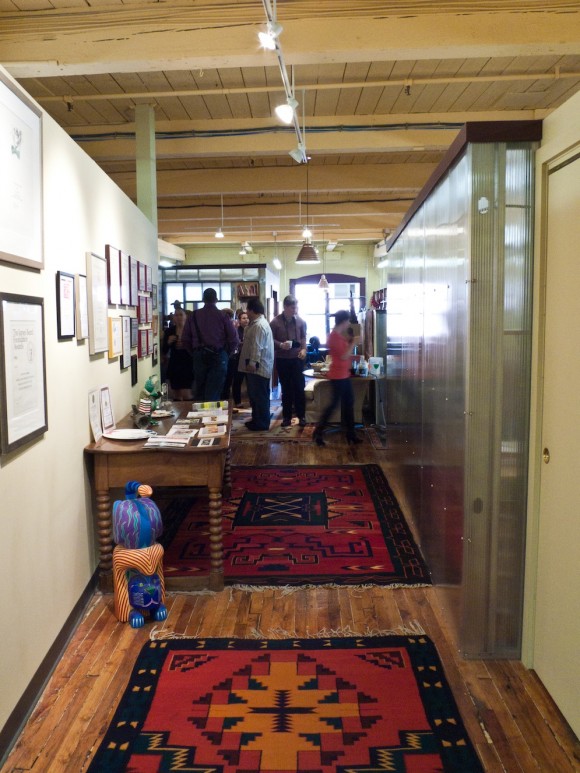



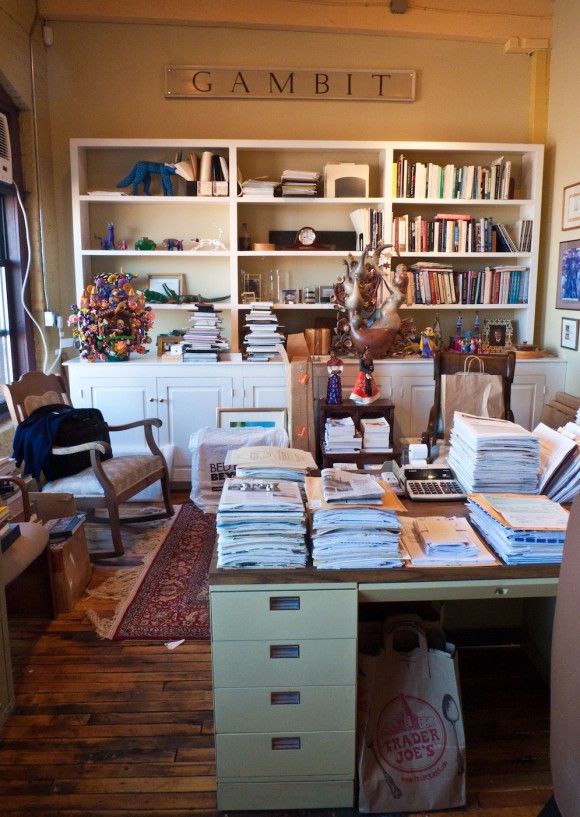

A big thank you to the kind folks at Harvard Common Press for letting me snoop around!
Harvard Common Press
HCP Dishes Blog:
HCP Blog Eats (new in the blog world): http://www.blogeats.com/
by Sam Tackeff | Jan 3, 2012 | Books, Soups

For quite some time, the prevailing mental association I had of Sweden was Jamie Lee Curtis in ‘Trading Places’ running around a train claiming to be “Inga from Sweden” – despite the fact that she was wearing Austrian lederhosen. I still find myself laughing hysterically at this film when it comes on TBS. If you haven’t seen it, please do.
As for my current Swedish associations, Inga has been replaced with IKEA, the chef Marcus Samuelson, Trina Hahnemann’s lovely Scandinavian Cookbook, and Stieg Larsson’s Millenium trilogy. (The Girl with the Dragon Tattoo books).
This weekend we went to see David Fincher’s version of “The Girl with the Dragon Tattoo”, which didn’t hold up for me as much as the Swedish films, which I adored.
What the movie did succeed in, was renewing my lust for the Swedish countryside. I became hungry for Swedish food. I wanted comfort food that reminded me of the simple, bare landscape. Also, I wanted comfort food that would help me to have the physique of Rooney Mara in her nude scenes of the film. Yes, I know that’s not going to happen. But loading myself up with healthy veg is a start.
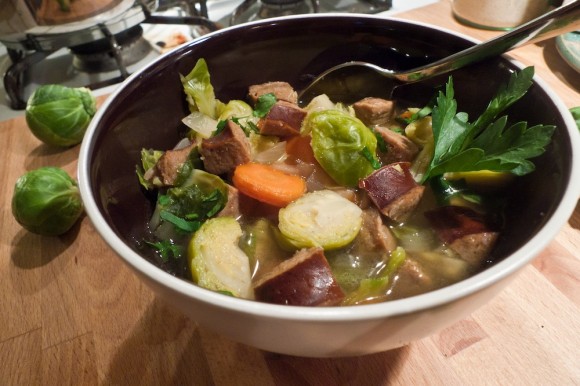
So I picked up my copy of Clifford A. Wright’s “Real Stew: 300 Recipes for Authentic Home-Cooked Cassoulet, Gumbo, Chili, Curry, Minestrone, Bouillabaisse, Stroganoff, Goulash, Chowder and Much More” (what a mouthful! a tasty mouthful) which I got on a field trip to Harvard Common Press, and flipped to this Swedish Sausage and Brussels Sprout number. She’s not the most beautiful, but is chock full of tasty ingredients!
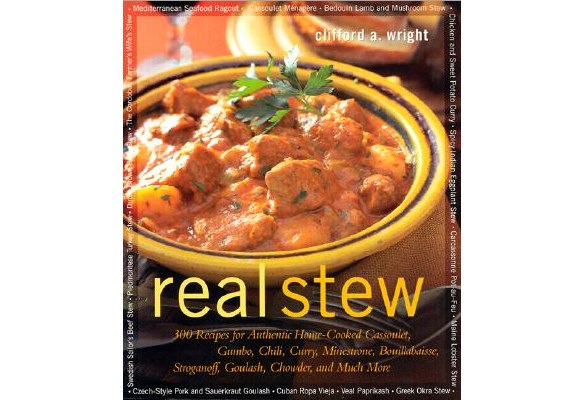
I’ve been cooking out of “Real Stew” for the past few weeks (beginning with a stellar recipe for “Classic Egyptian Lamb and Green Bean Stew). With New England weather the way it is, this cookbook came at the perfect time, right when I needed warming recipes for the quickly cooling weather.
I’m a big fan of any sort of soup, stew, or braising book, particularly when it is cold out and my strongest desire is keep warm and stir things for a couple of hours.
Real Stew isn’t full of glossy photos, but since stews aren’t usually the most photogenic, I wasn’t at all bothered. Wright does a marvelous job in the headnotes whetting your appetite for each recipe. The book is just as much a food history primer as it is a cookbook, and I learned a lot curled up in bed with it. (Although, this is unsurprising as Wright won a James Beard for food writing for his book A Mediterranean Feast. He is very good at the craft of cookbook writing.)
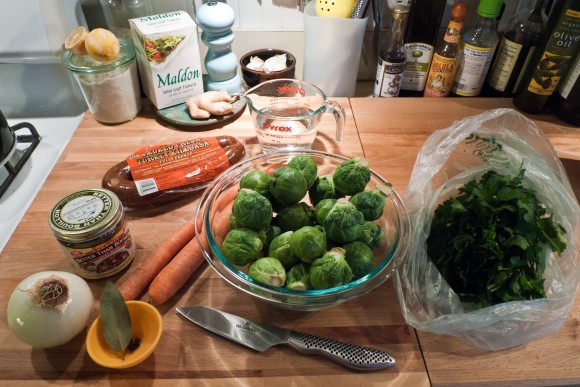
This is a very simple recipe that can be put together in under twenty minutes from start to finish.
I made this recipe almost to the letter, which wasn’t hard, as there were nine ingredients including salt and pepper. I used smoked Turkey kielbasa from Trader Joes, which made it tasty enough, but if you can get the Swedish sausage that Wright mentions, I’m pretty sure it would make this recipe spectacular. Rather than a bouillon cube, I used “Better than Bouillon”, which, unless you have home made beef stock on hand (and praise you if you do), is pretty much the bees knees.
Now, my one word of warning is: this soup tastes like Brussels Sprouts, which, may in fact be obvious, because it is one of the two main ingredients in the title, but you won’t convert Brussels Sprouts haters with this recipe. Which is fine, because that makes more for you.
Swedish Sausage and Brussels Sprout Stew
recipe by Clifford A. Wright, “Real Stew” p. 164
reprinted with permission from Harvard Common Press
makes 4-6 servings
“This stew is one suggested to me by my Saab mechanic Haken Wiberg, who tells me that this stew, called korv-och kal-gryta, uses a kind of sausage called falukorv (or falnkorv), which comes from the town of Falun, northwest of Stockholm. It is a thick, bologna-like sausage popular throughout Sweden and made of beef, lean pork, and pork fatback. Sometimes dried milk is added to it. It is then smoked before finding its way into stews. The Swedes are nuts about falukorv, as you will see by visiting www.falukorv.net on the Internet. In this recipe it is cut into chunks to cook, after peeling the skin off. A good substitute would be a small, one-pound mortadella sausage, such as that made by Arzuman (ask your store manager). Arzuman uses dried milk. If you prefer beef, try Hebrew National beef bologna. A Swedish housewife would typically use a beef bouillon cube, but if you do, make sure you don’t use more salt than called for because the cubes are high in sodium.”
1 pound small mortadella sausage or large cooked or smoked Polish kielbasa, skinned and cut into large dice
1 large onion, chopped
2 large carrots, cut into 1/4-inch-thick rounds
1 1/2 pounds small Brussels sprouts, sliced lengthwise into thirds
1 bay leaf
2 teaspoons salt
6 black peppercorns
2 cups Beef Broth
1 cup water
Finely chopped fresh parsley leaves for garnish
1. Put all the ingredients, except the parsley, in a stew pot, and bring to a boil. Reduce the heat to medium, cover, and cook until everything is tender, about 12 minutes.
2. Sprinkle with parsley and serve.
by Sam Tackeff | Dec 14, 2011 | Books, Gifts
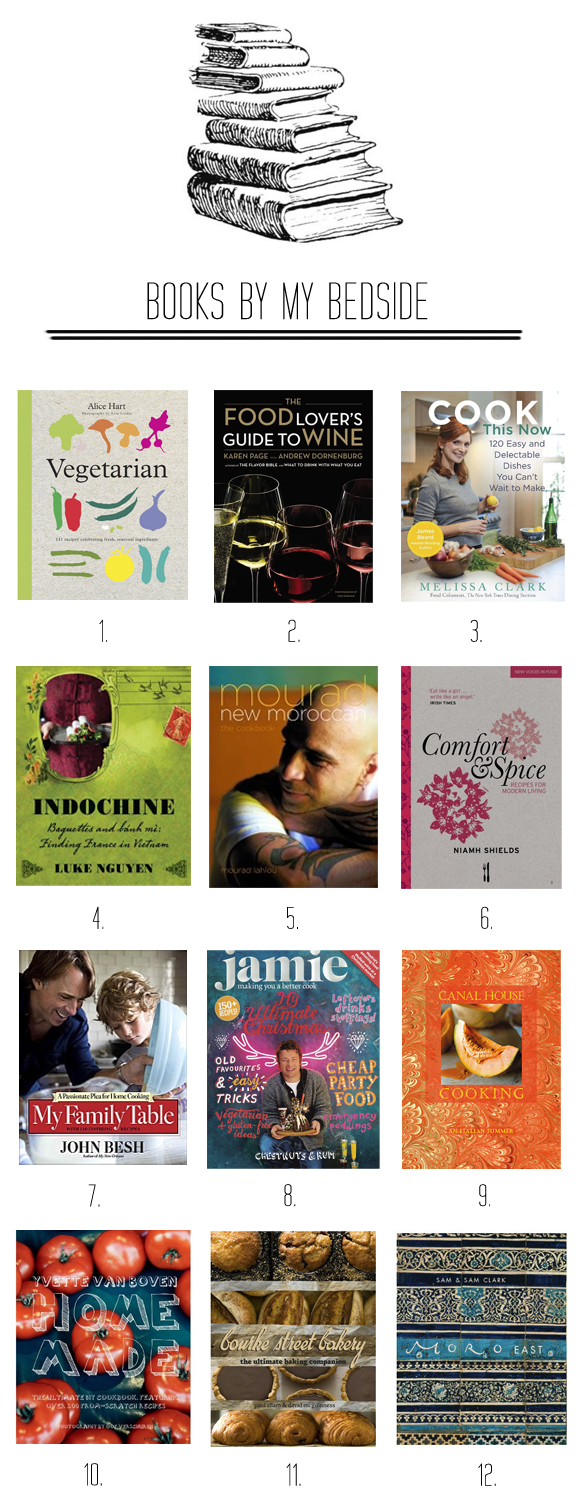
I read a lot of cookbooks (unsurprisingly). This is a small selection from the books stacked next to my bed right now*, and I’m still missing quite a few of my favorites. This was a very good year for cookbooks. I’m absolutely adoring all of these, and any one of them would make a fabulous holiday gift.
Image of stacked books from here. 1. Vegetarian by Alice Hart ; 2. The Food Lover’s Guide to Wine by Karen Page and Andrew Dornenburg ; 3. Cook This Now by Melissa Clark ; 4. Indochine by Luke Nguyen ; 5. Mourad – New Moroccan by Mourad Lahlou ; 6. Comfort & Spice by Niamh Shields ; 7. My Family Table by John Besh ; 8. Jamie Oliver Magazine, Christmas 2011 Issue ; 9. Canal House Cooking – Italian Summer ; 10. Home Made by Yvette Van Boven ; 11. Bourke Street Bakery by Paul Allam and David McGuinness ; 12. Moro East by Sam & Sam Clark.
What are your favorites right now?
* In fact, there are so many books next to my bed that they could form a small table, which, come to think of it, would be quite useful because I still don’t have very much furniture.






































